By Jesse Richardson
In March 2015, I launched a subscription service called Prospurly. For $44.95/month after a coupon, subscribers received 6-8 full-size, artisan products from small businesses and passionate modern craftsmen.
I’ll be honest with you: this was not a full-time gig. In fact, I generally was able to spend less than 5-10 hours a week running this business.
Despite the small time commitment, Prospurly grossed over $52,000 in its first six months of operation. On average, the business made about $8,000/month in recurring revenue with a 20-35% profit margin, depending on purchasing:

Customers were happy, churn was easy to manage (8-12%), and we partnered with dozens of awesome small businesses while also donating to great charities. (In fact, we were able to plant over 2,000 trees, helped protect clean water, and worked with a few great local nonprofit organizations. And that was just in the first few months!)
Instagram posts of our charity efforts. (And yeah, that’s a Mark Ruffalo tweet).
So, how did all of this come together?
Step 1: I chose an idea.
The first step began about 2 months before I collected my first dollar.
Back in January 2015, I started thinking about how I wanted to learn the Cratejoy platform. I’d been involved with subscription commerce since my days as a founder of Conscious Box (started in 2011 in a tiny single room office with beds installed above our desks), which was originally held on a static site, then moved to Magento. After Conscious Box, I helped start a slew of other subscription business, which mainly used integrations with Chargify and WordPress.
Cratejoy was a new “all-in-one” platform, which intrigued me. Customer information, creating subscription products, one-time purchasing… all in one? I wanted to give it a try.
So I brainstormed. Why not start something new using Cratejoy?
I had never started a business alone. It was a scary — but exciting — thought.
Which interest(s) would it serve? What would the curation look like? What would be the niche of the business?
I knew two things from the start:
First, it would involve natural products sourced from small, local businesses. My parents have been small business owners, environmentalists, and avid about conscious living their entire lives. They have served as great sources of direction for me (in both life and business).
Second, I decided my subscription box would not deal with product sampling. This likely meant that I would be purchasing products.
While the juices were flowing, however, I was still struggling with the true inspiration for the project.
Then, one day, while reading The Consolations of Philosophy by Alain de Botton, I struck up a train of thought inspired by Epicurus. As de Botton explained, Epicurus was a far more modest man than many presume him to be. To him, happiness as an “acquisition list” was actually quite simple.
No large villa was needed, no expensive foods or drinks were necessary, and no fanciful luxuries. It’s nothing like the modern understanding of Epicureanism.
Cratejoy is an all in one subscription commerce platform that includes everything you need to start your own subscription commerce business online. Try it free for 14 days.
Rather, to truly be happy and experience pleasure, all one naturally needed was flavorful food, good friends, and an examined, thoughtful life.
Despite being in a marketer’s position, which in some ways ran contrary to Epicurus’ fundamental message, I was inspired by the simplicity of his ideas: food, friends, and thought.
I’d craft a subscription around living a life not just directed at happiness, but a life directed at prosperity.
After a few sessions of playing with names, ideas, and synonyms, I’d ended up with Prospurly – a play on living “prosperly”:
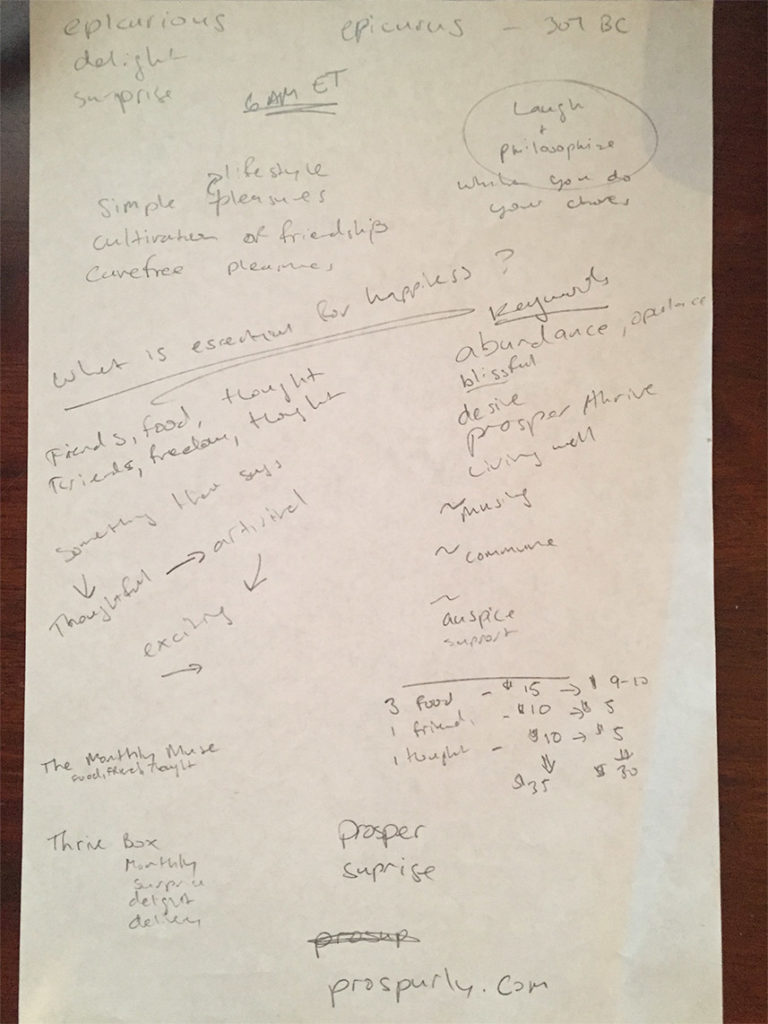
I really liked it when it first came together on the page. It was short, felt clever, and it intrigued those around me when I pitched the idea. It was also fun to say.
More importantly, there were very few subscription businesses already started in the area of “small-batch, artisan lifestyle products for bath, body, and home.” It was something of a Crate-&-Barrel-meets-subscription-boxes-meets-living-well.
The idea felt awesome. I loved the direction, the name, and the implications that the niche would have on the business (like making regular donations to charities, as shown above).
So the idea was there: a natural lifestyle brand inspired by the experiences and simplicity of a happy life. The subscription would deliver the so-called “ingredients for a happy life” — items and ideas that cultivated a life much like the one I thought Epicurus might’ve imagined — with a bit of an artisanal touch.
Interested in curating your own artisan box? See how a subscription box could impact your Etsy sales with our Etsy Calculator!
Step 2: I kicked off with a prelaunch.
Personal excitement aside, I needed to make sure that Mom wasn’t the only one who thought this idea was good. I wanted other people who didn’t know me at all to tell me this was something they’d pay for.
So I decided to run a prelaunch email-gathering campaign.
A prelaunch email-gathering campaign is a strategy used to test the market’s response and build initial buzz around a product. When it’s done right, you’ll have hundreds or thousands of emails from interested people who will become your early customers, should you decide to launch your product.
This is not hard to do. (In fact, Cratejoy even includes a prelaunch theme now!)
At the time, I chose to set up a Launchrock page. It was a simple platform, easy to customize, and had templates that looked good. It made gathering early emails and testing messaging, colors and offers easy while I built the rest of the business.
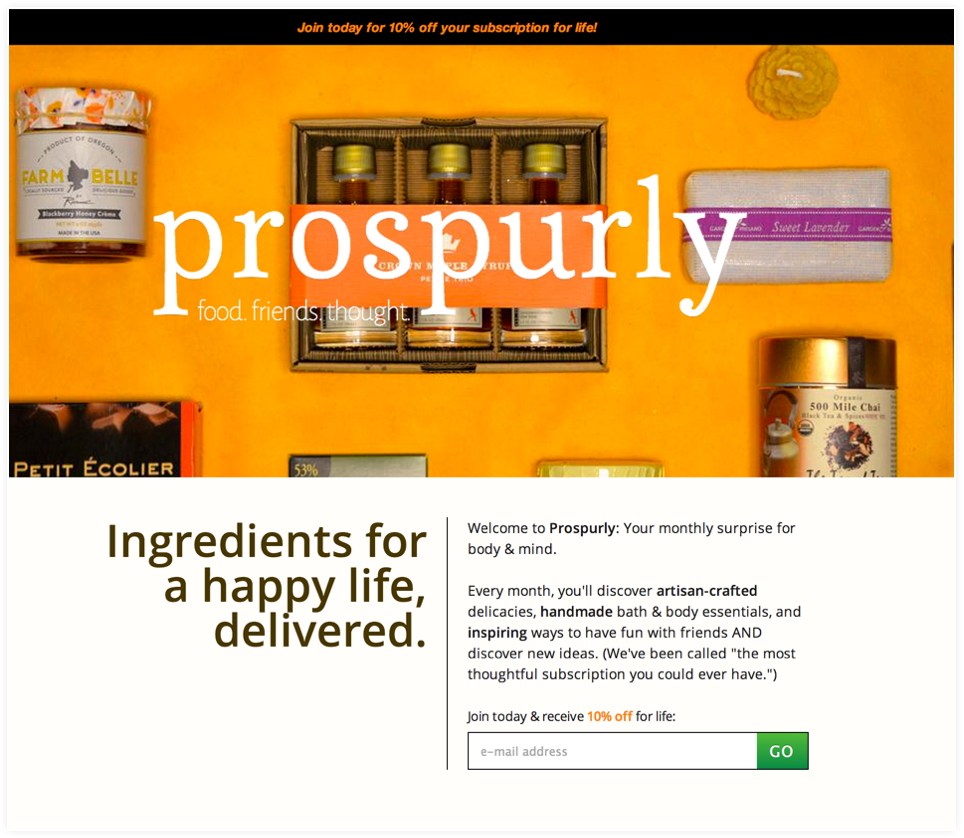
I took a picture of a few items I thought would fit the niche, with an orange-colored paper background, snagged from my local art shop. The goal was to keep the page bright, colorful and effective at capturing the “sunny” spirit of the business.
Next, I began building out my social channels, which would serve as my primary sources of early traffic. I started with the simple ones: Facebook, Twitter, Pinterest, and Instagram.
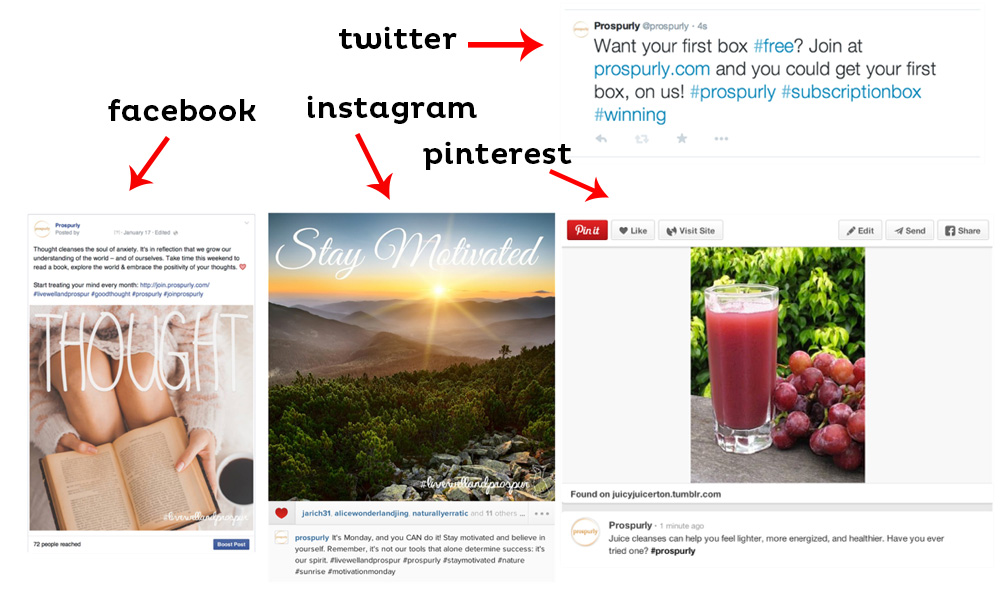
To get these in front of people, I used the basic (and free!) functions of these social media channels. I used hashtags, invited friends and family to like and follow my channels, and interacted with other users by liking their posts, following them, sharing their posts on Facebook, and staying active with comments.
I also spent a lot of time on Instagram, building out ideas and testing branding:
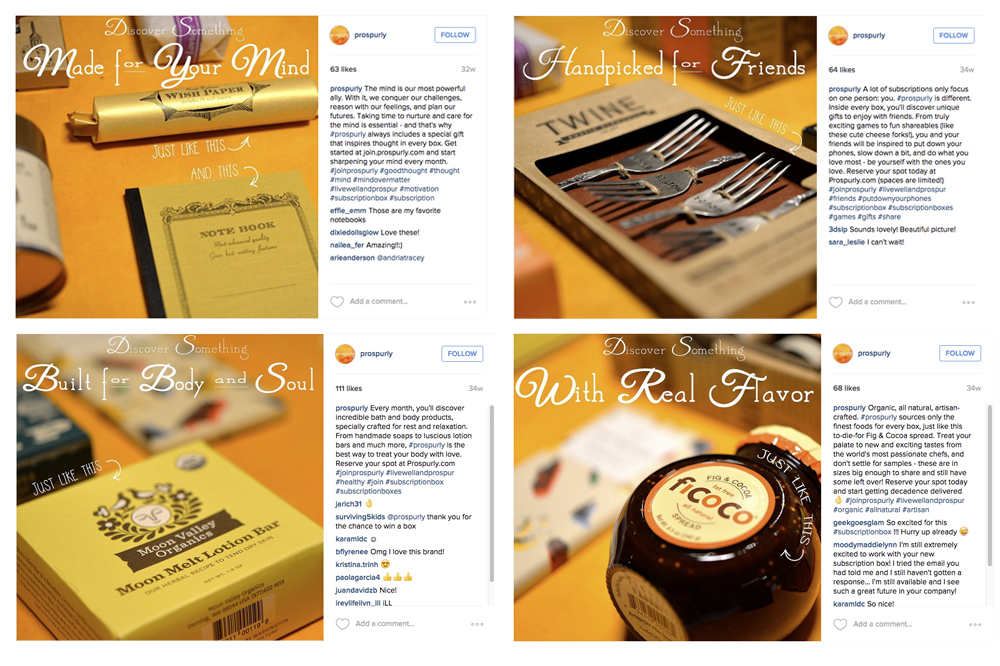
My prelaunch campaign ran on one thing: the natural reciprocation of social media users. I liked photos, they liked mine. I followed them, they followed me. It created momentum, the perception of authority, and helped me push traffic to my landing page.
You might notice that these early posts jumped around with branding, fonts, and wordings. Frankly, I was learning the ropes of actually applying creative design. (While I’ve been “creating” these for years, I’ve never actually been the one to hold the pen in Photoshop.)
Was I some experienced designer? No.
Had I ever launched a business completely on my own? Nope.
But the tools were there. I watched YouTube videos on design, scoured the internet for guides, and made a point to post a few times a day on my channels, openly asking people their thoughts. Slowly, things evolved and began to take shape.
Alongside learning the creative process, I began to work out other customer acquisition strategies:
- Established a blog called “The Prospurly Post” (good for SEO purposes and organic traffic)
- Contacted bloggers, reviewers, Instagrammers, and other social influencers I planned to reach out to and offer a box
- Identified similar niche publications and pages with which I might trade exposure
- Studied videos about Facebook ads and asked friends who had seen success for tips
- Snagged a Google ads credit and planned an early advertising campaign
Early on, the prelaunch began to get some traction:
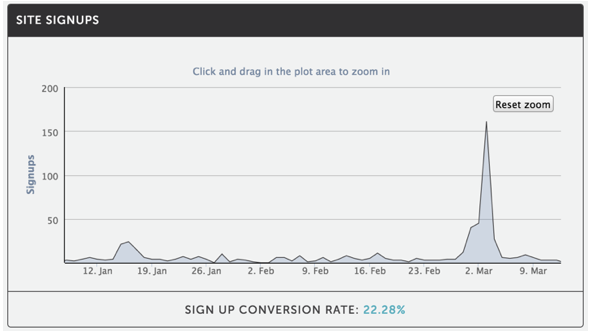
Over about 12 weeks, the page saw the following:
- 2679 total visitors
- 209 total shares
- 597 total signups
- Total Conversion Rate: 22.28%
- Total Share Conversion Rate: 7.8%
For a total of almost 600 pre-subscribers and a conversion rate of 22.28%, I felt AWESOME. (One Quora reported that most people see between 9-11% conversion rate, with the occasional answer in the 20s and 30s.) Most of this traffic was from social media, so the early design work I played with felt validated — it piqued interest and pushed qualified traffic to my landing page.
I made a point to keep the list “warm” over the weeks, sending out updates and sneak peeks. This was a big asset for the launch, and I hoped it would yield a strong customer base. Here’s an example of a sneak peek:
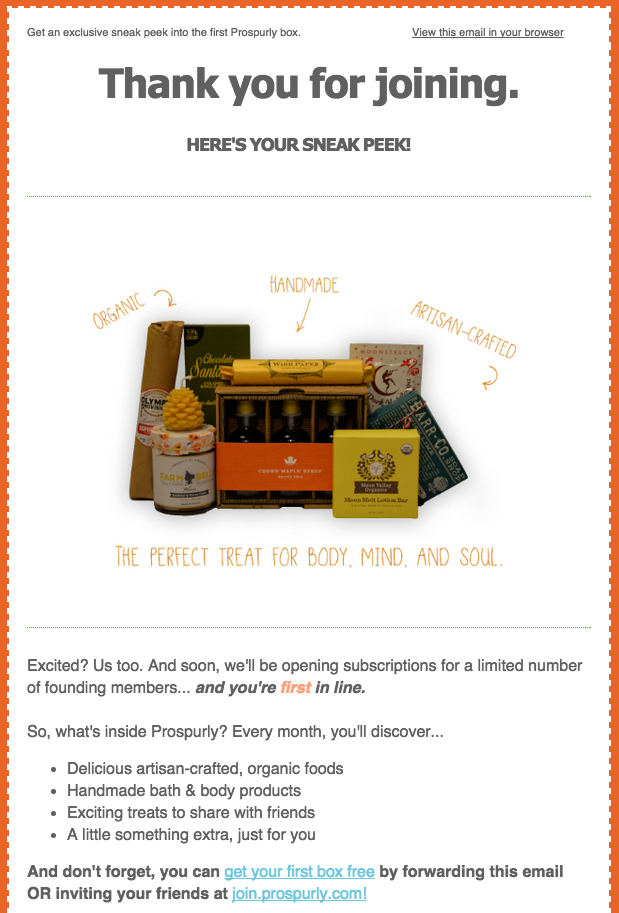
Step 3: During prelaunch, I developed tools.
From past experience, I knew I needed to build some foundational tools for the business before I reached my official launch: namely, a CRM to keep track of merchants, a customer support platform, accounting software and cash planning, and an appealing invitation for brands.
But wait, you ask — what even is this stuff?
- CRM: This stands for a Customer Relationship Management tool. It’s like an electronic Rolodex. It’s super useful for keeping track of vendor partners (brands, in other words, not subscribers) when sourcing products for your box. You can catalog leads and add notes, along with a bunch of other cool features. Part of running a subscription business means servicing brands, and CRMs make it simple(r).
- Customer Support Platform: It’s a waste of time to deal with support requests in a regular email client (like Gmail or Hotmail). Queries from customers can get lost easily and you don’t want to risk that. Customer support platforms take emails from a support address and feed them into a system where you can apply extra features to speed things up.
- Accounting Software: If you’re starting a business, you need to keep your books straight. This means reconciling transactions in your bank account and accurately measuring expenses, revenue, and profit.
- Cash Planning: Outside of accounting software, using a cash planning spreadsheet makes projecting your future profit margins much easier. This is done in Excel, and you can use templates, like Cratejoy’s budgeting tool.
- Brand Invitations: These are PDFs that you attach to your sales emails. They quickly provide vendors with more information without you having to type it out each time. Like the CRM, these are useful when servicing your second type of customer: brands.
So let’s jump into it:
First, the CRM. I decided to use Solve360. I’ve seen this CRM in action, used it before, and it fit in my price range, so it felt like the right choice.
I kept the entry process simple: basic company information, tagging based on product category and location (I try to source locally), and notes for when I contacted someone or received replies. I also learned how to use other features, like scheduled emails and events. After finding businesses on Etsy, Google, or at my local stores, I’d enter them in:

The first month, I added about 150 qualified leads. These were businesses who fit the niche and had applicable products. As part of this, I decided a theme for my first box – “Awake with Spring” – which was general enough to fit many types of products. When it came to choosing products, all I needed to do was ask, “Does this fit a spring/awakening theme?”
Next up, customer support. Even though I didn’t have customers yet, I was getting inquiries from potential customers. I also knew that setting this up ahead of time would save me time down the road.
For the platform, I used Zendesk. It’s affordable and has easy-to-develop tools, like macros, triggers, and automation. (I had one person managing it, and it usually took less than part-time.)
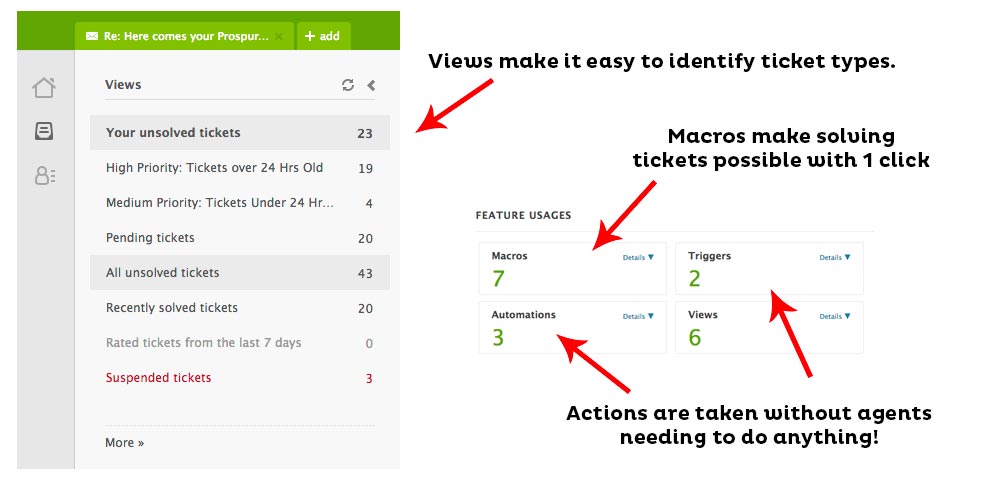
For accounting, I used Xero. I rarely “owned” this task in past ventures, so this took a bit of learning.
To keep me crisp on the process, I set up a weekly reconciliation meeting in my Google calendar. Every Friday, I started my day by linking up transactions from my bank account in Xero. This made taxes, cash planning, and keeping my books straight much, much easier. You can also create rules in Stripe, Cratejoy’s recommended payment processor, which makes reconciliation faster.
It was also at this point that I really started to drill down on pricing and the unit economics of the business.
I began by assuming a pricing scenario that allowed me to purchase slightly below wholesale. To start, most businesses will offer products for bulk orders at wholesale, which is usually 50% MSRP. Wholesale is rarely (in my experience) a negotiation — all you need to do is ask. From there, I took the total MSRP I wanted to see in the box, and worked backwards to find my budget for products. I assumed average prices (Cratejoy’s Subscription Business Calculator makes this easy), and made a projection:
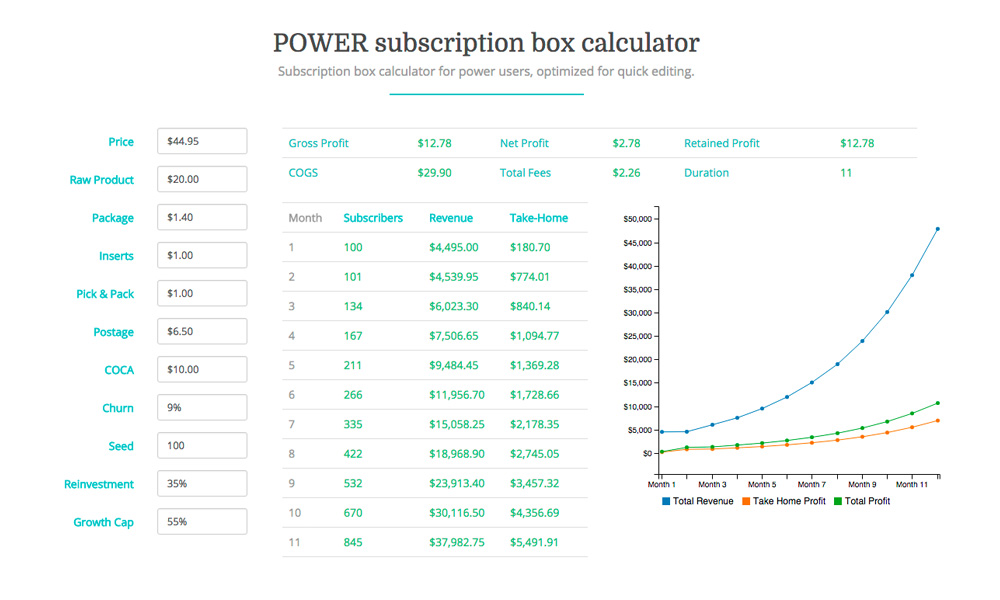
After adding a few dollars for shipping, packing, printing, and services, I had a cash planning worksheet I could use alongside Xero.
The final item on my list was building out a sales deck – a PDF with basic information about Prospurly and reasons why brands should join. Sales materials are helpful because they allow you to keep intro messages short – just a few lines asking about product availability and wholesale cost. If a merchant is interested, they already have a resource to read over. This also helps add a level of professionalism to your business, which always helps during negotiations.
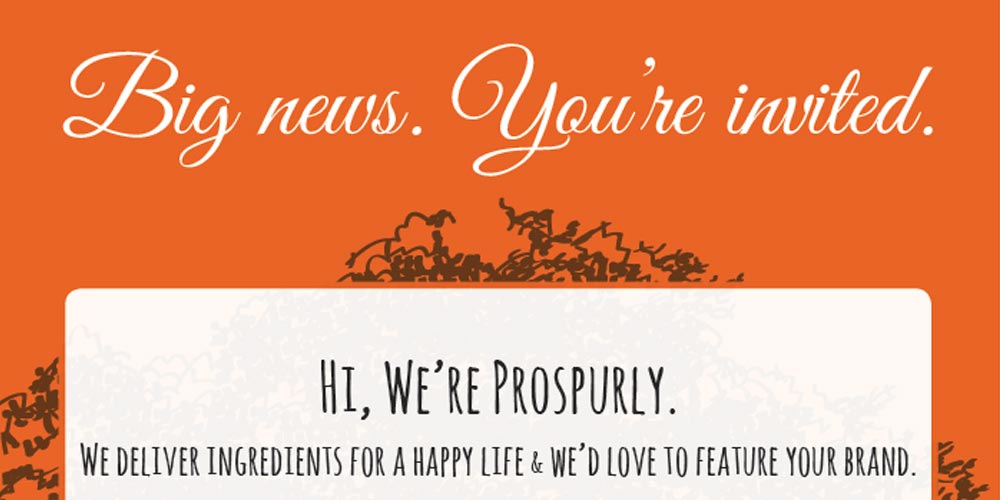
From there, I enlisted the help of a local developer to customize my Cratejoy website a bit. To find him, I simply posted an ad on Craigslist. It took me sorting through about 5-6 people, but I eventually found someone with a decent portfolio and competitive rates ($35/hr).
For the work, I knew I wanted to add more dynamics to the page: a few sliders, a custom pop-up (I use OptinMonster), an Instagram slider, a better footer…you get the idea. I didn’t spend much – about $200 for the work.
Here’s the evolution:
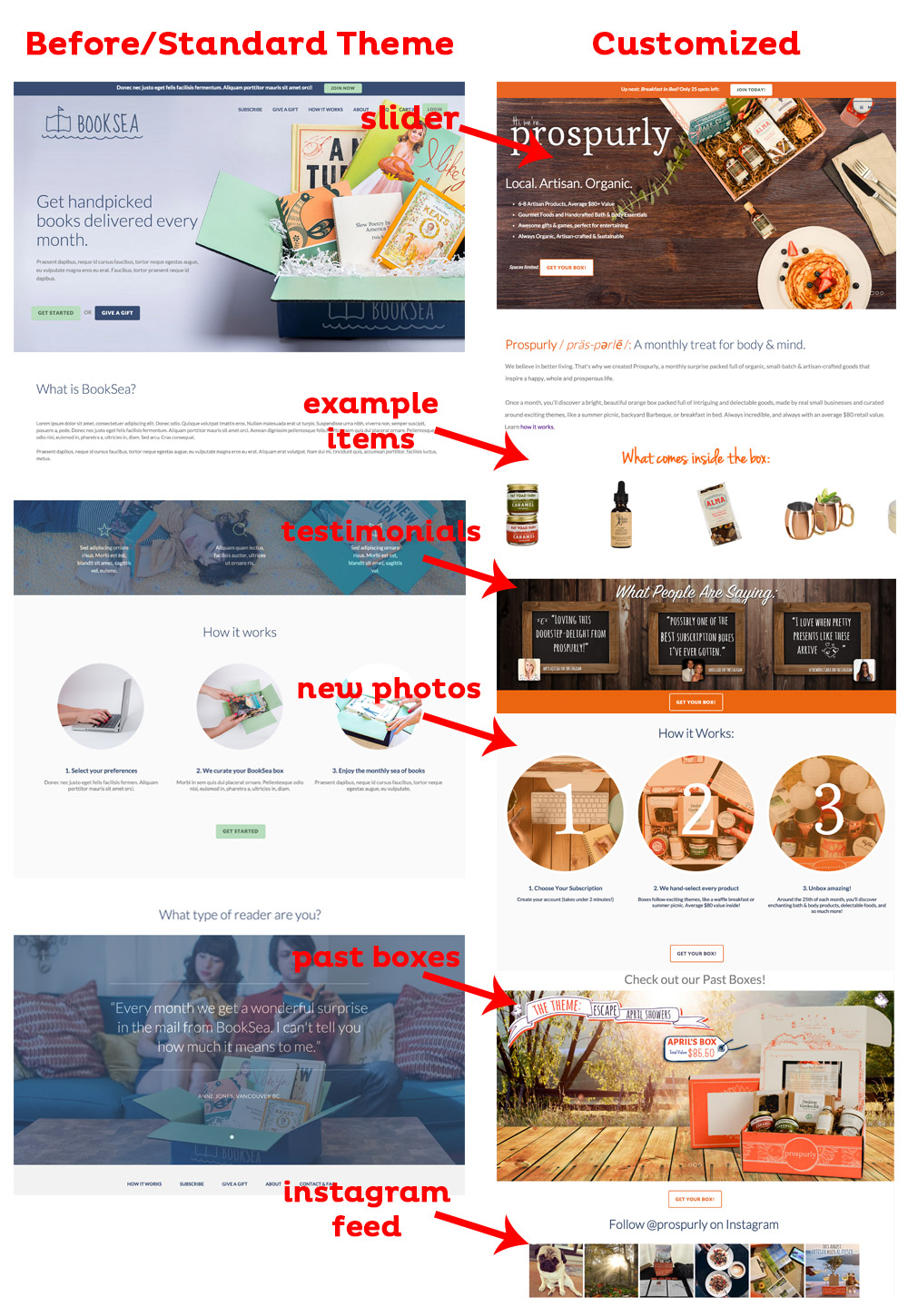
When it came to spec’ing this all out, it was pretty simple.
First, I made a mockup in Photoshop. I took a screenshot of my current website, moved things around, added in exactly what I wanted, and added red arrows, just like you see above. Because I have worked with developers before, I knew I needed to draw this out, not just explain it in text.
Next, I listed out specific directions to the developer. This didn’t mean I wrote the code or made specific code-related suggestions (after all, I’m not a developer). Instead, I wrote out the changes I made to my mockup in an itemized list. Here’s an example of some early requests I made:
He’d make an update, I’d check it out, and he’d add more changes if I had any. We also collaborated a bit on what he thought would look good.
In addition to the tools and website, I had also been designing custom boxes. This was probably the most tedious and time-consuming process of my launch, since I had literally never opened Adobe Illustrator before.
Here’s the rough order of operations I tackled:
- I decided a box size. I wanted to ship in the USPS cubic 0.20 range, and I maxed out the size possible for that. You can go with a “standard box size,” which a box manufacturer can suggest to you (as they have different standard sizes from manufacturer to manufacturer), or you go with a completely custom box, like me. This means I’d have to buy dies for cutting the cardboard in addition to the plates for the custom colors. Cratejoy’s custom box design partner, BoxUp, doesn’t charge for dies, but other companies will. (PS: You can use the Cratejoy Shipping Calculator to learn more about cubic pricing!)
- With a box size decided, I went to local box manufacturer NW Paper Box to talk about the type of cardboard and pricing. I had used them in a previous venture, Escape Monthly, so I had a rapport with them. (If you don’t know the manufacturer you’re considering, it’s as simple as making a cold call and setting up a meeting to talk about needs.)
- I decided to go with a kemi or “white top” board, so when I printed orange ink on the box, the background would be white.
- I spent a few dozen hours on design, usually iterating 2-3 times on each version. Then I applied subtle changes and focused on refining my skill set early on. Once I felt comfortable, I’d work on adding more unique design elements.
For the template, I simply grabbed a blank box design from online. You look closely below, you’ll see the actual dimensions of the box outline changed twice before landing on the correct size. In this final case, I was provided with an Illustrator file from my box manufacturer. Here’s the initial template I used:
Now that I had a template, I began working on the design:
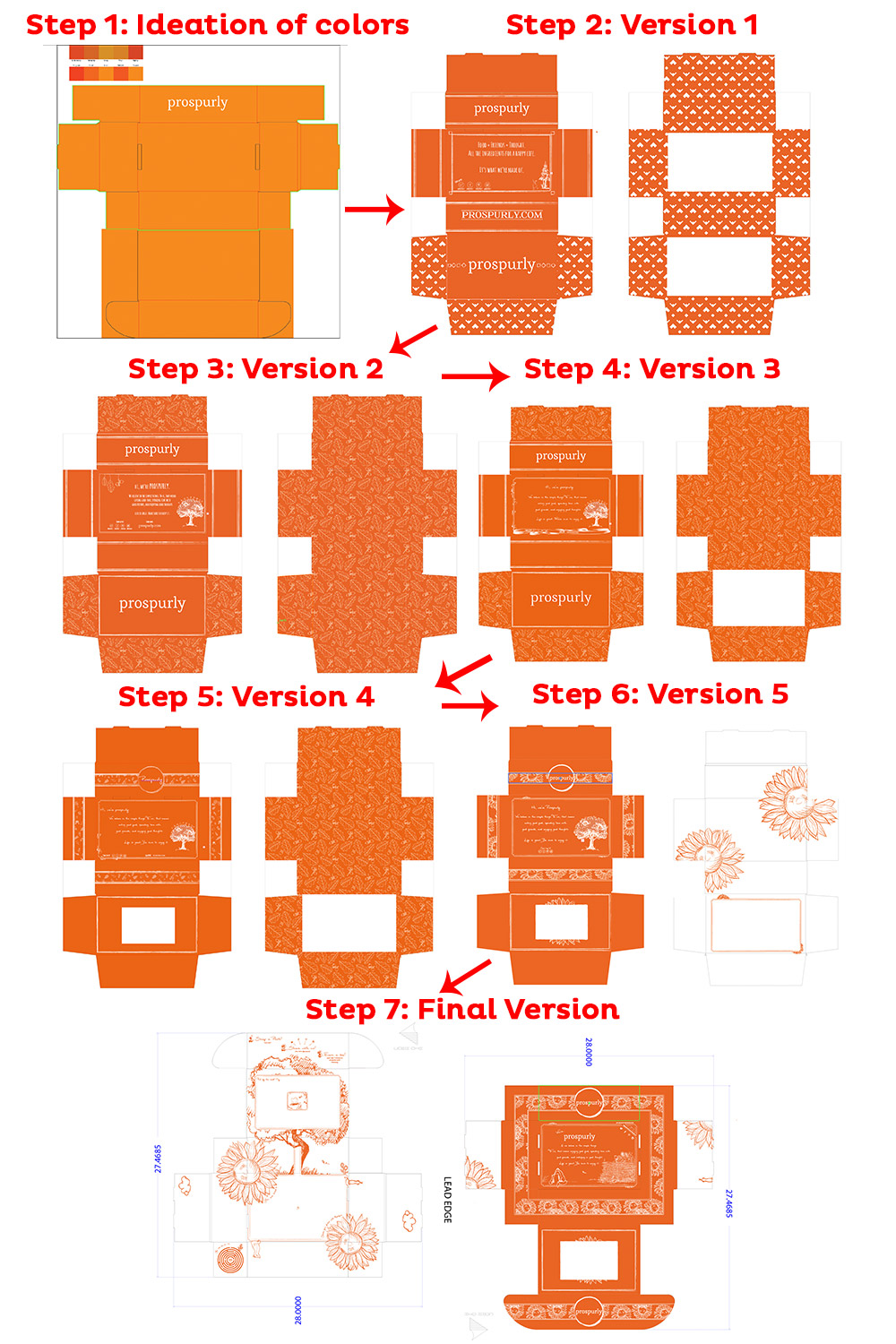
After I decided on a design, I put the order in for a few thousand boxes.
NW Paper Box would then split payments for creating the custom plates and dies, and I would use the boxes as needed each month, while storing the excess in their facility. Splitting payments, with 1/3 of the total plate and die costs (about $700 each payment) paid over the next 3 months, helped cash flow during the early months of the business. Paying for boxes as needed also helped smooth out my COGS (cost of goods sold).
Design your own custom boxes through the Cratejoy box program! BoxUp offers high-quality boxes, fast shipping, and special prices, only for Cratejoy sellers.
With a decent site in hand and custom boxes on their way, it was time to launch.
Step 4: Launch time!
Weeks of work led to this.
I had no idea how the early adopters would come in, and with the investment for custom boxes, I was starting to sweat about expenses (I was about $2,000 in, which included boxes, services, and everything else).
Fortunately, the first box came together nicely:
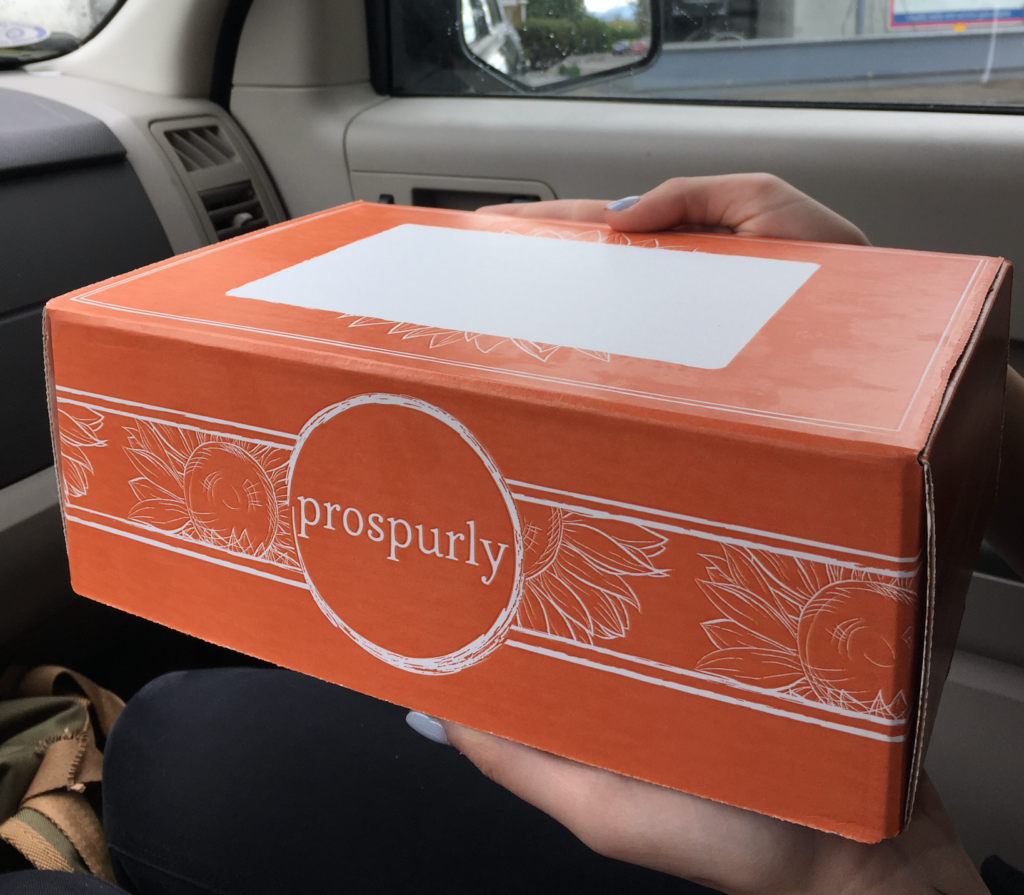
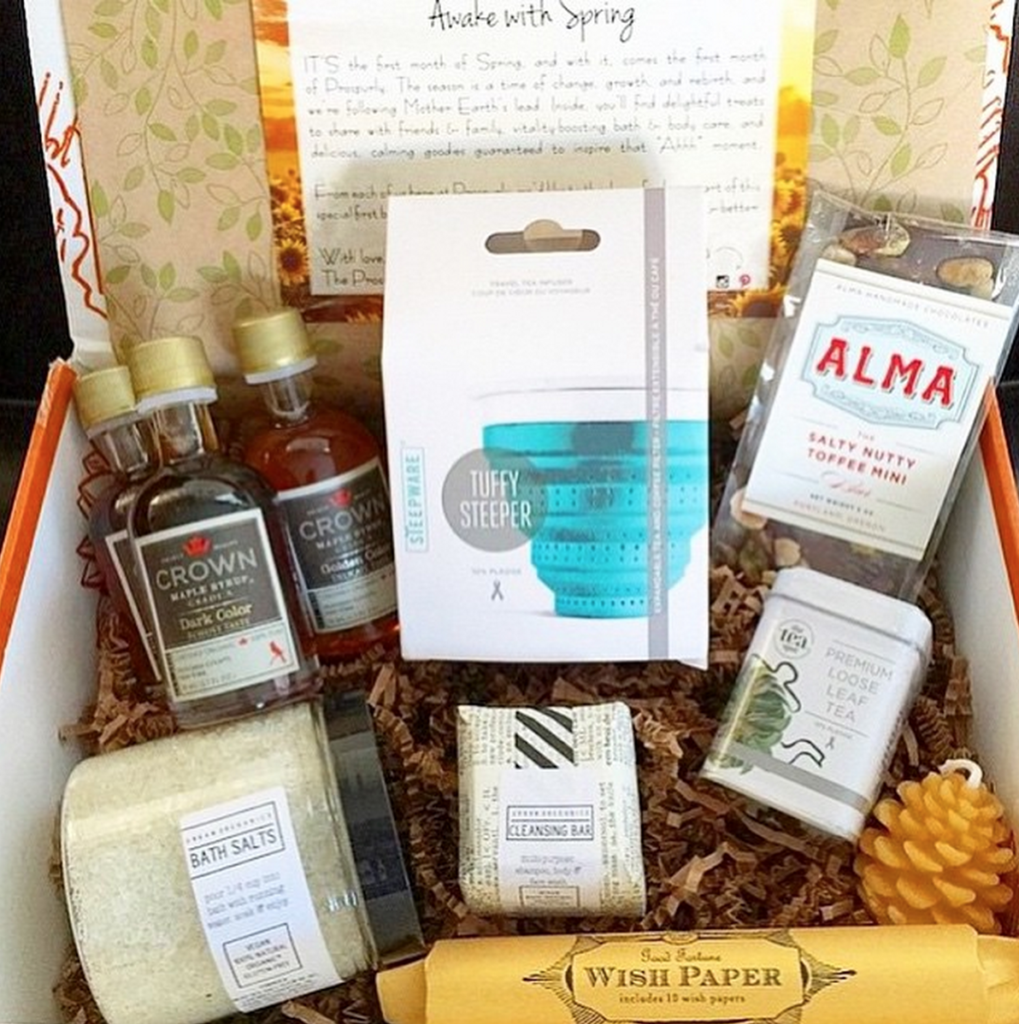
I was confident once people received it, Prospurly would gain momentum.
I started with a countdown on social media. We were giving away boxes, doing shout-outs and working hard to interact with the community online. We did this across all our social channels. Here are some examples from Twitter:
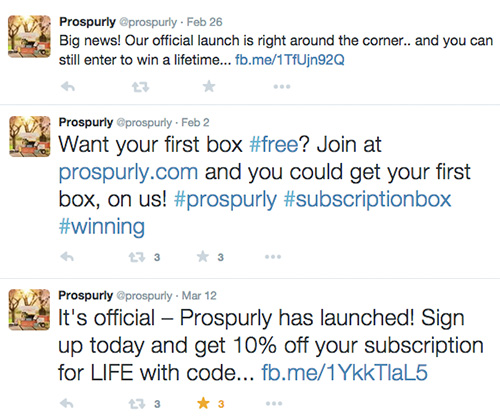
We also led a countdown on Instagram every day before the launch:
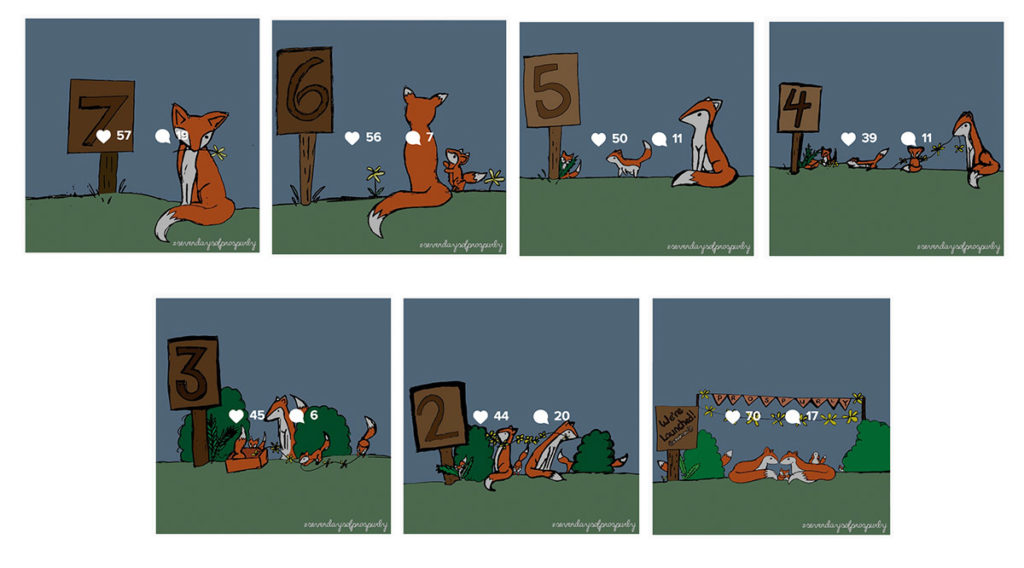
I also sent updates to the leads lists, which was now at its fullest. I scheduled 4 emails for the week of the launch for my leads list. The emails would go out every other day leading up to our official opening of sale. They followed basically the same verbiage in each email, and looked like this:
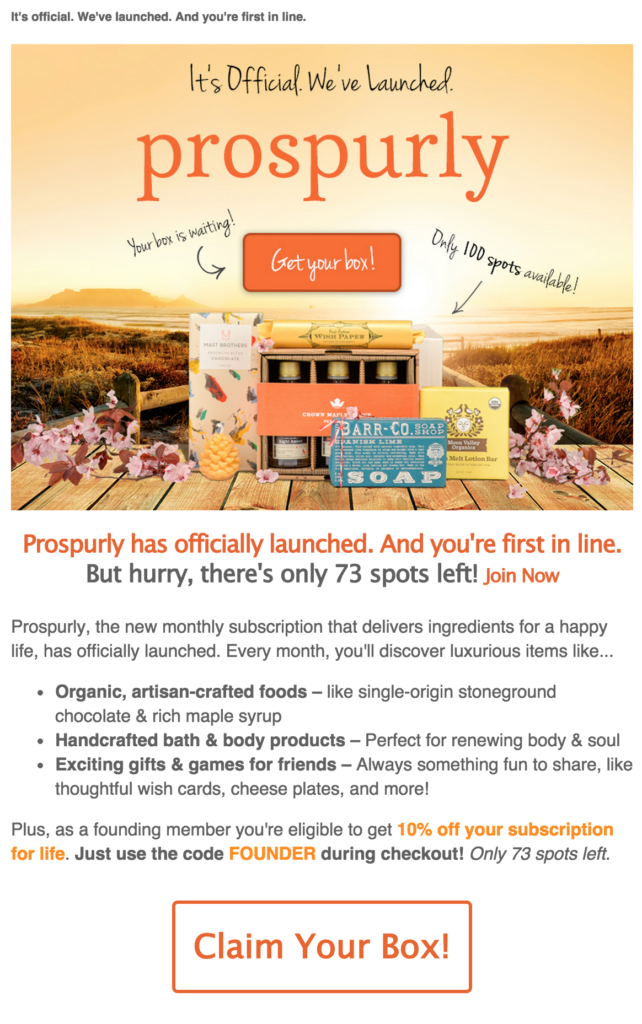
Within the first day, we saw results. For starters, the emails saw decent open/click through rates:
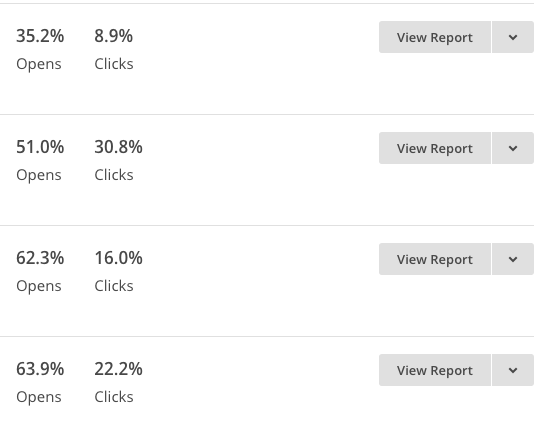
Social media was also abuzz, and we rocked a few of our simple promotions.
We had been holding a contest for a lifetime subscription, which people entered via presubscribing on our launch page. It was easy for people to enter: all they had to do was just presubscribe on the launch page. I would then choose an email at random from the list, contact that person, and announce them on social media. After the launch, we announced the winner and got some decent sharing for doing so.
During the launch month, we ran contests for reposting our photos and tagging friends for chances to win one-time boxes.
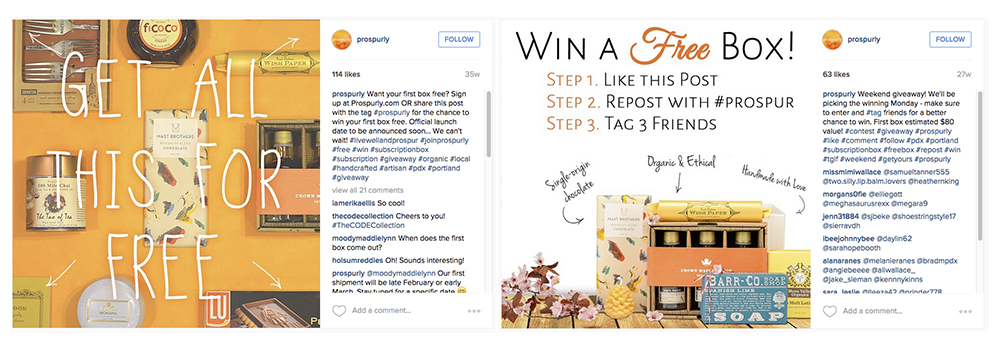
Additionally, we released a special coupon for “founding members” – aka our first customers – for 10% off for life + a bonus in their first box.
In the first 30 days, I sold over 120 subscriptions and grossed a little over $5,600 – more than enough to cover products, shipping, and start paying back the investment I made for custom boxes (which was completely optional, but I found very valuable).

Considering that I’d been working full-time, exiting another business, and was a novice on most of the early operations, this felt like (and was) a huge launch. I was thrilled with the results, and best of all, this gave me a platform for a highly sustainable, rewarding business.
Now it was time to grow — and grow we did.
In the first six months, we effectively doubled in size, grossing about $10,000/month with about 200-220 subscribers. On a monthly basis, that comes out to a 10.14% growth rate, on average. In other words, by dedicating just a portion of my schedule, I was fortunate enough to capture back the number of churned customers each month, plus track down some additional customers.
Step 5: Keeping at it.
Since launching, I was able to templatize the business enough that the little downtime I did have could be spent thinking of new ways to get customers. While I didn’t need to work every day, my daily schedule mostly focused on procuring the next month’s products, tinkering with emails, and improving my skill set on core tasks.
For example, I improved at branding and general creative skills:
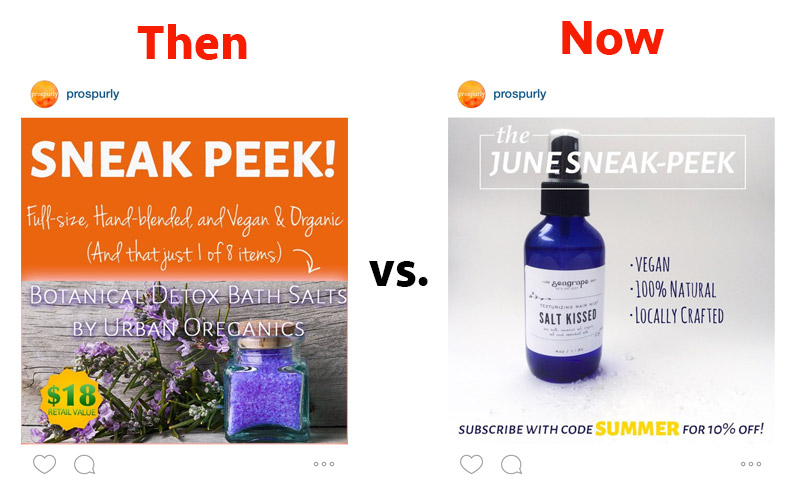
It goes to show you how much one person can improve with a little, concentrated effort.
And this was true across all operations.
- Procurement became easier: Prospurly worked with dozens of local companies and artisans across the US, and people took notice. We’ve been featured in a few decent-sized publications and online outlets, like Buzzfeed, and worked with dozens of social influencers a month. This added a really unique marketing perk to our business for brands.
- The sales deck improved: I redesigned it, added more features, and profiled more brands. This made for a more compelling pitch to my partners and sped up conversations.
- Accounting was quick and easy: With Xero and a cash planning sheet in Excel on lock, I could quickly budget and forecast growth, making this once-scary operation simple and manageable.
- Shipping became a 60-minute task: With Cratejoy’s platform and easy-to-manage batch shipping, this operation boiled down to a 60-minute or so task each month. I would send a PDF right to my fulfillment partner and never have to worry about labeling, packing, or shipping boxes.
- Social media grew: With over 5,000 people across my channels, our social media channels gained natural momentum and required less work. People were more inclined to repost photos without us directing them to — because they saw so many other people do it — each month.
So what about financials? While I decided to reinvest as much capital in the business as possible, I was able to pay friends and family members for work in our first six months, ultimately giving myself greater control and, more importantly, a better quality of life. The financial security this offered felt extremely stabilizing and rewarding.
In all this, the first lesson I learned as a student of business remains true: trying to run a business (mostly) alone is difficult, difficult work. Putting aside the actual tasks you need to execute, the mental and emotional commitment it demands is nothing short of extraordinary. It’s a test of your hard work and your willingness to accept failure.
But it’s possible. And by following the model I’ve presented, chances are you can develop something similar with a bit of hard work, time, and a dose of luck for good measure.
Now, I’ve got to get back to work.
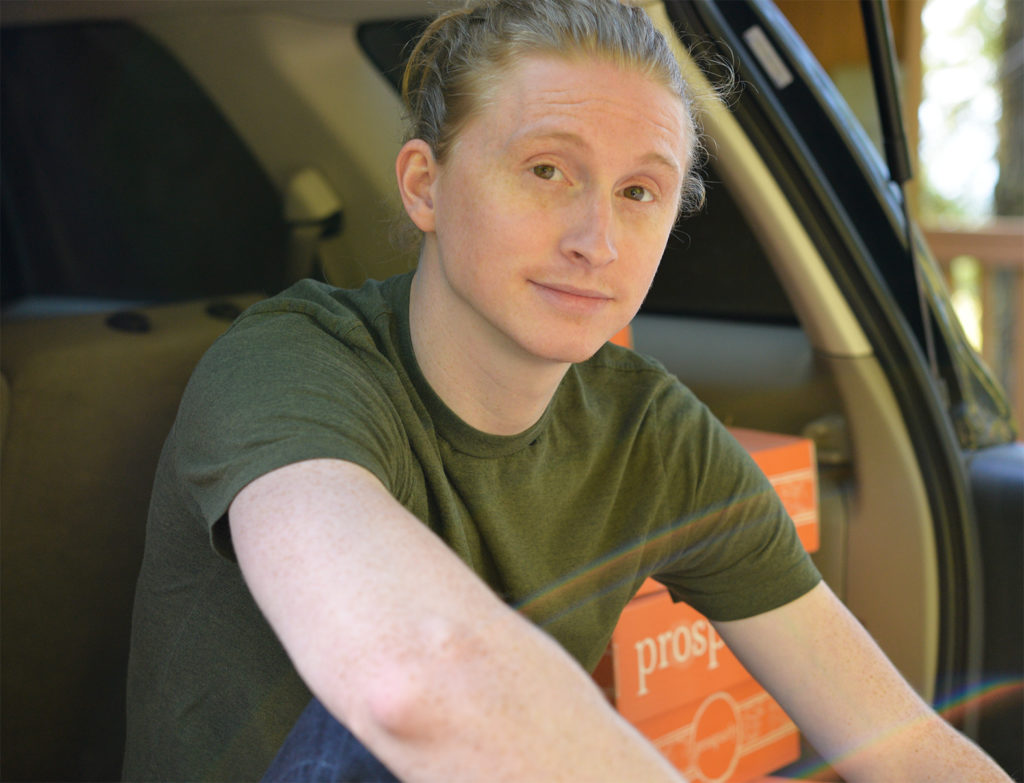
Cratejoy is an all in one subscription commerce platform that includes everything you need to start your own subscription commerce business online. Try it free for 14 days.
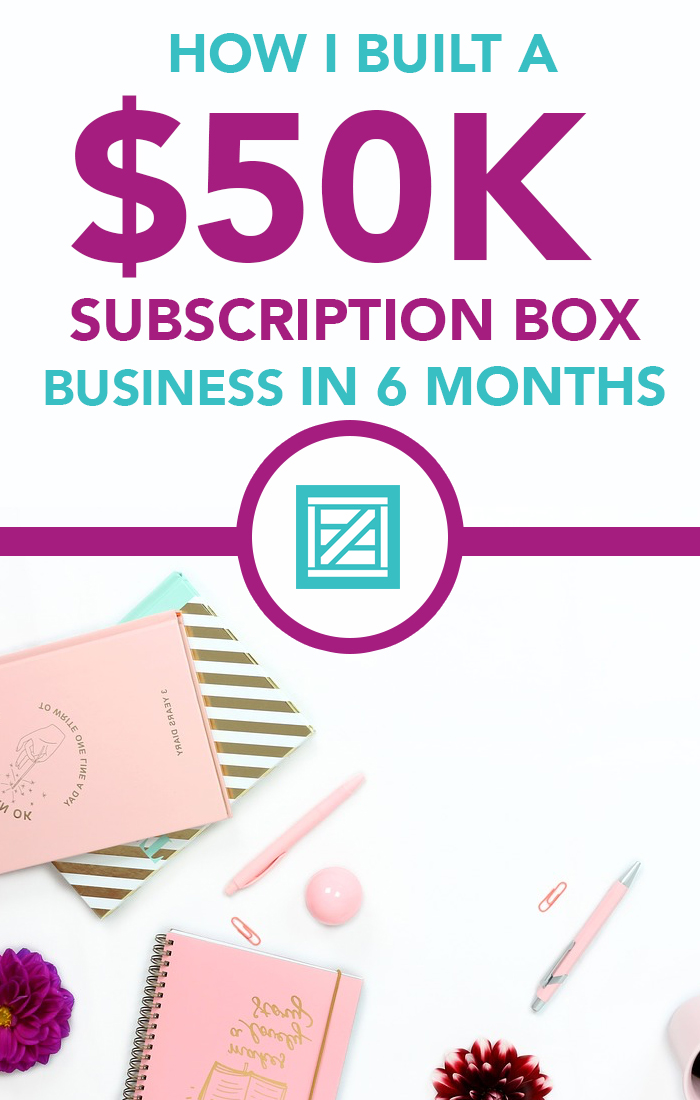
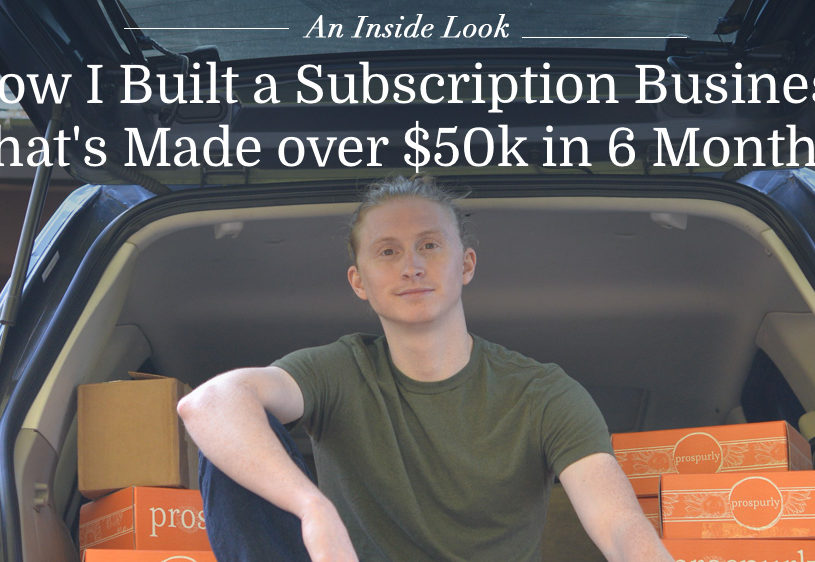
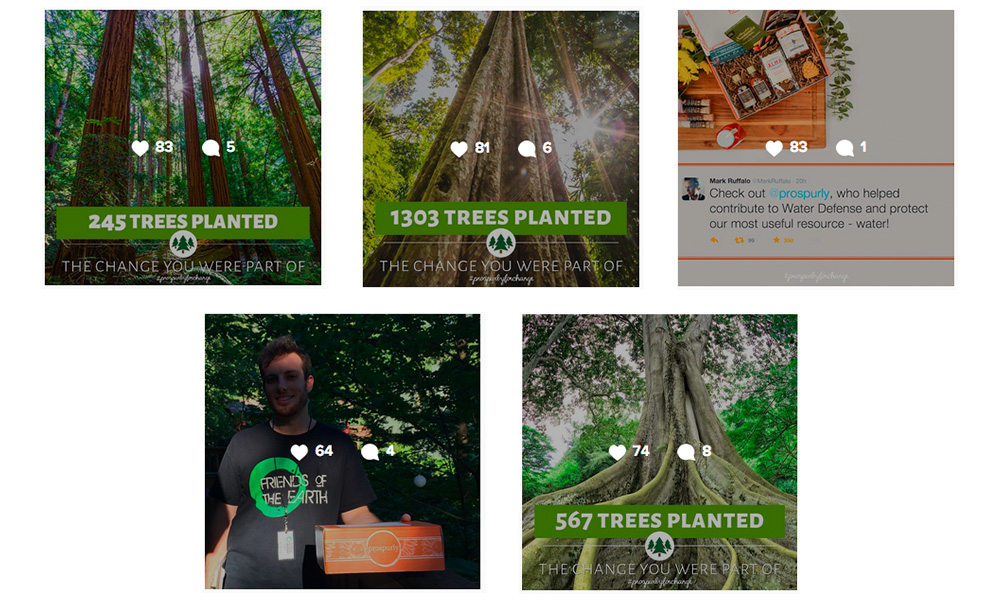
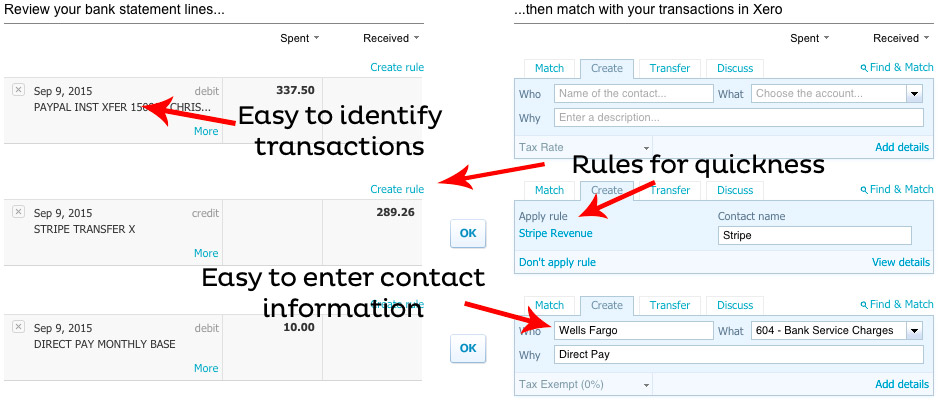
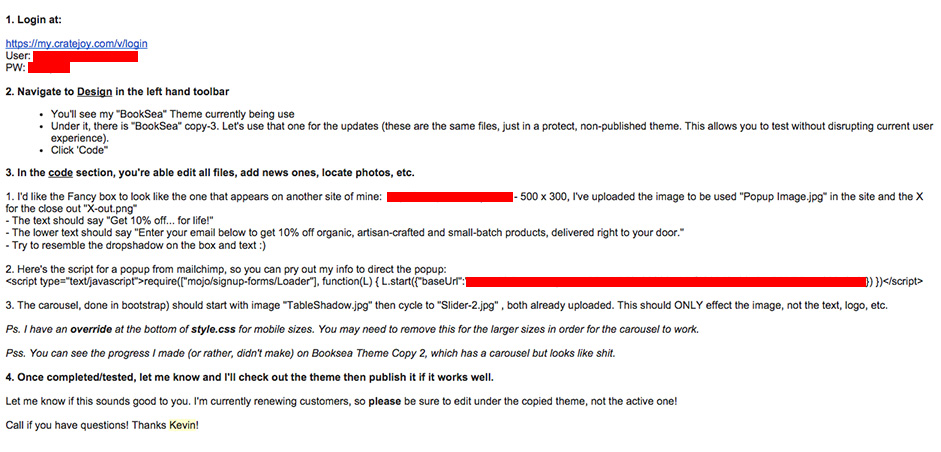
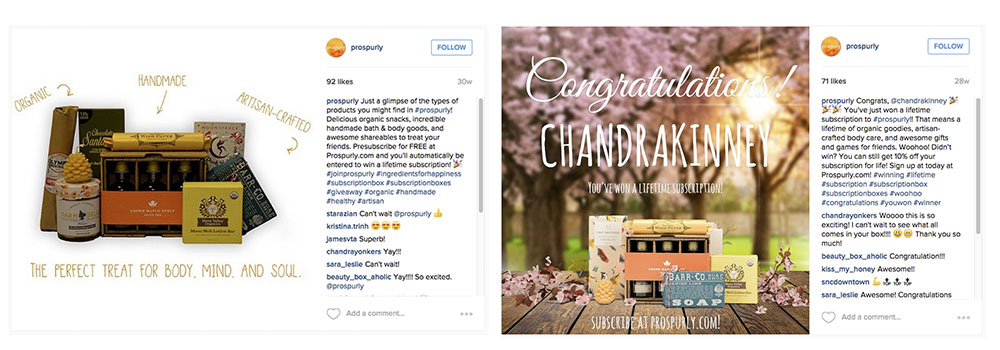
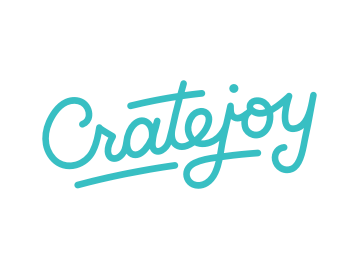
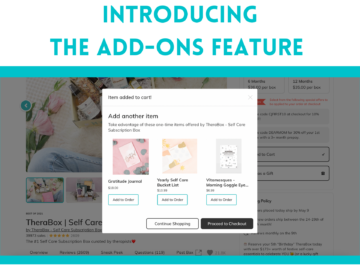

Thank you for this! I have an idea for a subscription box but I don’t even know where to start. Love the articles on here. So helpful. Downloading the PDF now 🙂